Last updated on June 19th, 2024
56. High Point is known as the Furniture Capital of the World
The city holds two major trade shows, one in April and the other in October, every year. The High Point Market is the biggest furniture trade show in the world, bringing more than 75,000 people to High Point, every six months. Almost 2000 exhibitors participate in it.
57. The city is also home to the biggest furniture store in the world.
58. Barbecue Capital of the world
Lexington is famous for its barbecue and is the self-proclaimed Barbecue Capital of the world. However, during some years, the Davidson County town rolls out its popular “Pigs in the City” exhibit featuring statues of pigs in uptown, dressed in sunglasses and other fun attire. Businesses sponsor the fiberglass pigs, while residents and tourists enjoy the porky photo ops.
59. Famous craft beer
One of the towns, Asheville, is famous for its craft beer tradition. People come from miles around to taste different craft beer at its markets. It has a lot of breweries because of the local interest, more than any other town in the USA.
60. If Christmas lights make you happy, visit the Tanglewood Park’s Annual Festival of Lights
If Christmas lights make you happy, you must drive through the Tanglewood Park on Christmas eve. From running dears and squirrels to flying eagles and everything else, the displays will fill you with the Christmas spirit.
61. Full of Festivals
In December, Harkers Island, part of the Outer Banks, comes alive with festivals on the first weekend. The Core Sound Decoy Festival has been held on this island every year since 1988.
62. Inseparable since 1926
Mt. Olive Pickles and the town of Mt. Olive have been inseparable since 1926. The company remains at the original site, and each New Year’s Eve residents and visitors can enjoy the town of Mt. Olive’s annual pickle drop.
63. Live music venues
You can find the best live music venues at the Red Hat Amphitheater in Raleigh, North Carolina. The state’s best cultural institutions and nightlife can also be found in the capital.
64. Your trip to North Carolina is incomplete without a sip of Cheerwine
Cheerwine is often referred to as the “nectar of the Tarheels.” Also, despite its name, there’s no wine in Cheerwine. Cheerwine is a cherry-flavored drink that has lesser caffeine than Pepsi and Coco-Cola. Cheerwine is the oldest family-owned soft drink company.
65. Collection of Wesleyan Staffordshire Pottery
The World Methodist Museum at Lake Junaluska was built in 1956 chronicles Methodist history. Visitors will find numerous artifacts, including rare books, manuscripts, poetry, replicas, and the most extensive collection of Wesleyan Staffordshire Pottery in the world.
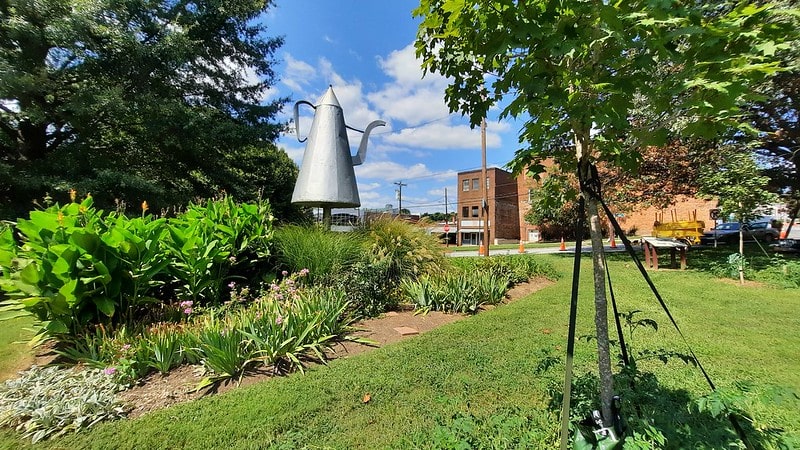
66. Old Salem Coffee Pot, Winston-Salem, North Carolina
The Old Coffee Pot is a 7-foot coffee pot made of tin. It was built by Julius and Samuel Mickey in 1858, two Moravian brothers who worked as tinsmiths.
67. History of the centuries
A living history museum can be found in the historic old Salem, where you can see how people lived in the previous century. Other historic attractions are also available in the city of Winston-Salem, North Carolina.
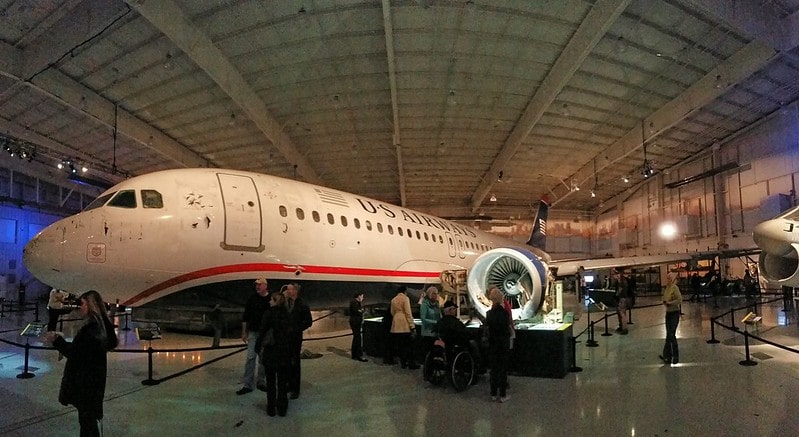
68. The “Miracle on the Hudson”
Charlotte is the home to the “Miracle on the Hudson” plane known as US Airways’ Flight 1549 and piloted by Captain Sully Sullenberger. The Carolinas Aviation Museum at Douglas International Airport houses the aircraft. Sully and survivors of the storied flight visited the site to commemorate the tenth anniversary of the “Miracle on the Hudson.”
69. Laurinburg-Maxton Aircraft Boneyard
This aircraft boneyard in Maxton, North Carolina, is the resting place of retired DC-10s, 747s, and 727s, all of which are planes flown by Northwest Airlines. Plane parts are now being sold for scraps.
70. The old well at Chapel Hill
The Old Well is one of the most interesting historical facts of the University of Carolina at Chapel Hill. It was the main source of bathing and drinking water for many years.
71. Mugs are in plenty
The House of Mugs in Collettesville sounds like a gift shop, but it is an eclectic collection of thousands of mugs that cover a cabin and other structures on a property. The owners invite visitors to add to the collection by bringing and hanging a mug if they can find an empty spot.
72. If you love architecture
Raleigh’s Daily Planet Theater is a fascinating piece of architecture in downtown. The massive globe is about five stories high and 70 feet wide and is close to a scale replica of the earth. The globe appears to have rolled against the side of a building and is said to be the second-largest earth on earth.
73. A water spitting head
David Černý’s Metalmorphosis in Charlotte is a giant polished steel kinetic water-spitting, head-shaped fountain at the Whitehall Corporate Center. The colossal, eye-catching piece weighs 14 tons and features mirrored, stacked layers that rotate 360 degrees with all layers coming together to reform the shape of a head during rotations.

74. Homeless Jesus, Davidson, North Carolina
This statue is a depiction of Jesus as a homeless man lying on a bench in the park at St. Alban’s Episcopal Church. The bronze sculpture shows Jesus covered by a blanket with only his feet showing, with his crucifixion wounds visible. The statue is in the middle of a well-to-do community.
75. A statue an award-winning musician
A statue of Doc Watson, a Blues legend from Deep Gap, North Carolina, can be seen on a bench on Kings Street, Boon. They also celebrate this award-winning musician on the yearly Doc Watson Day, June 18.
76. The Can Opener, Durham, North Carolina
The Can Opener is a railroad trestle that was so-named because it was too low for big rigs, standing at just 12 feet and 4 inches high. If any careless driver dares to cross, let’s just say that the can opener will do its job of decapitating the topmost portion of the vehicle.
77. A lighthouse by the name of Frying Pan Tower
Frying Pan Tower in Southport was built 32 miles off North Carolina’s Coast in 1964 as a lighthouse to prevent ships from running aground in the shallow waters of Frying Pan Shoals. Previously operated by the Coast Guard, the tower is now a non-profit project used for education, recreation, and research.
78. The Lost Colony
The Lost Colony, which has mystified historians all these years, used to live on Roanoke Island, North Carolina. The only clue of their whereabouts is the word ‘Croatoan,’ carved into a tree.
79. Twin Poplars, Lenoir, North Carolina
The Twin Poplars are two poplar trees that appear to grow together. The trees are separated at the base but their trunks appear to grow as one. According to legend, two warring factions of Native Americans, the Cherokee and the Catawba, decided to make peace and tied two trees together so they will not grow apart. The Twin Poplars stand firm to this day.
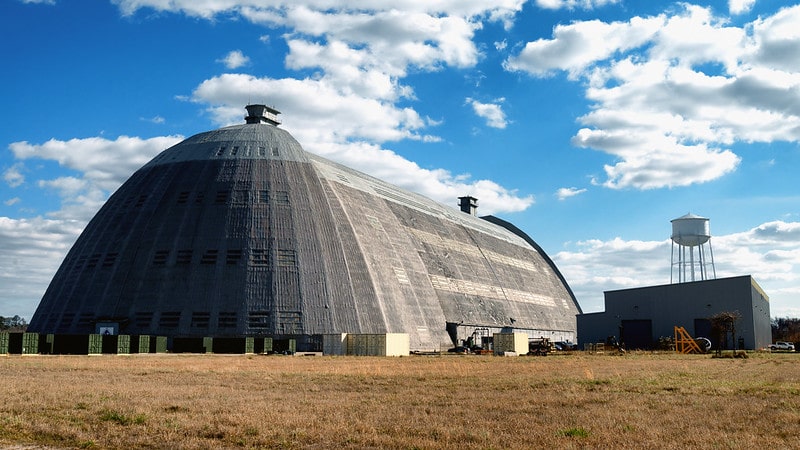
80. Weeksville Airship Hangar
The silver-toned Weeksville Airship Hangar was built in WWII for the manufacture, storage, and maintenance of blimps owned by the U.S. Navy. These airships were filled with helium and were deployed to observe the waters for incoming enemy ships. The hangar could house about 12 blimps that were at least 250 feet long.
81. A carnivorous plant
Wilmington is the home of the Stanley Rehder Carnivorous Plant Garden. It’s not often that most people get a glimpse of carnivorous plants in action, but at the Rehder garden, visitors can see Pitcher Plants, and Venus Fly Traps up close and personal.
82. Appalachian mountains
After a professor from North Carolina lost his life in the Attakula Mountains, it was renamed the Appalachian Mountains. Many exciting things are going on on this mountain these days.
83. A hidden gem
Winston-Salem is home to a hidden “gem” known as Bath Branch Falls. The site is described as a place where water flows over rocks into a deep gorge surrounded by vegetation. Surprisingly, this mysterious and natural beauty located in the heart of the city is hard to find—unusual since other cities might create a destination around such a treasure.
84. Clean and green
Cary has made it easy for residents to ride their bikes or walk around town. With 200 miles of green way and biking paths, residents can bike or walk to work, school, parks, and other destinations, contributing to cleaner air and a sustainable community.
85. A tribute to the first flight
The Monument to a Century of Flight in Kitty Hawk consists of 14 wing-shaped, stainless steel pylons that start at 10 feet tall and ascend to 20 feet and set in a circle measuring 120 feet. The 120-foot circle is symbolic of the distance of the first flight by brothers Orville and Wilbur Wright. Visitors can read the panels on the pylons to learn about events that have impacted aviation.
86. Tribute to soldiers
Fayetteville became a sanctuary for soldiers in 2008. The city and Cumberland County declared the area “The World’s First Sanctuary for Soldiers and Their Families,” with the pledge to “watch over those who watch over us.”
87. Part of the treaty to end the Civil War
On April 26, 1865, North Carolina took part in the end of the Civil War. The generals of the two sides met in Durham, North Carolina, to discuss the terms of the Confederate’s surrender.
88. Greensboro, North Carolina
The sit-ins in Greensboro, North Carolina, had a significant impact on the civil rights movement. In the 1960s, four African Americans took a stand at the Woolworths whites-only lunch counter.

89. North Carolina may have invented Pepsi, but its state beverage is Milk
The state of North Carolina is famous for wines and is credited with the invention of Pepsi, and yet its state beverage remains Milk. Adorable, isn’t it? Along with being an excellent source of calcium, milk is also a great source of vitamins A & B, potassium, magnesium, phosphorus, and protein.
90. Four feet high Official Flower
The Official state wildflower of North Carolina is none other than the Carolina Lily. This plant grows about four feet high and can be found all over the state.
91. Devil’s Tramping Ground
Nothing will grow in the famous barren circle known as the Devil’s Tramping Ground in the pine woods outside Silet City. People believe the place is cursed and the devil himself is wandering in this space.
92. No elephants
A strange law in North Carolina is that elephants may not be used to plow the cotton fields. There are no elephants in this region of the US, but someone may have tried this at some point; that’s why the law exists.
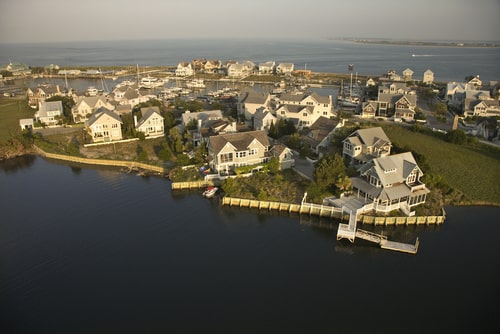
93. Cars are not allowed on the Bald Head Island
If you want to get away from the hustle and bustle of the city life, head straight to the Bald Head Island. The island boasts 14 miles of beaches and a complete absence of cars.
Travelers can opt for either golf carts or bikes or choose to walk. Bald Head also has the state’s oldest standing lighthouse, Old Baldy and an exciting marine life scene.
About the Flag of North Carolina
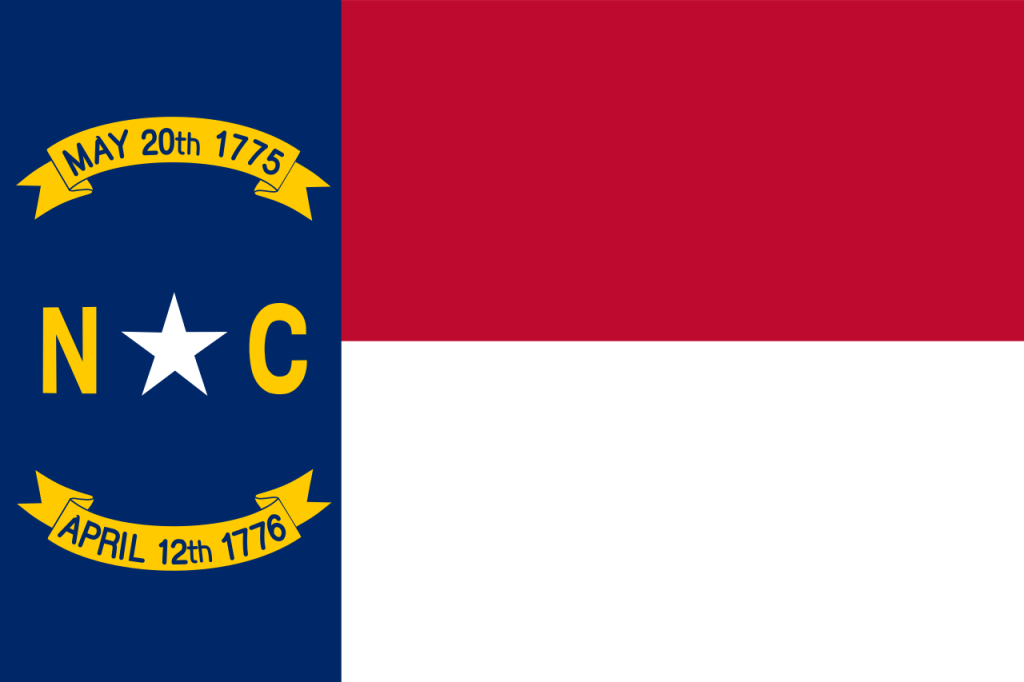
1. Design and Symbolism
The flag of North Carolina highlights the state’s leadership in the American independence movement. It has three sections: blue on the left, red at the top, and white at the bottom.
On the blue band are the initials of the state separated by a white star. It is roughly the same height as the letters “N” and “C.”
Above this is a gold scroll with “MAY 20TH, 1775.” It is the date of the Mecklenburg Declaration, considered by some to be the first recorded declaration of independence within the 13 Colonies. It came out of Charlotte, North Carolina, from a committee of citizens in Mecklenburg County.
Meanwhile, under the star is another scroll with “APRIL 12TH, 1776” – the date of the Halifax Resolves. It empowered the state delegates to vote in favor of independence in the Second Continental Congress. The resolution paved the way for the US Declaration of Independence three months later.
2. Adoption
On March 9, 1885, North Carolina adopted a state flag with the design of Johnston Jones. It was last modified in 1991.
3. Technical Details
The flag uses a proportion of 2:3. The upper and lower bars are of equal size. The length of the horizontal bars is the same as the dimension of the vertical blue bar.
4. History
North Carolina was the twelfth state admitted to the Union on November 21, 1789. Locals probably made several flags during the Revolution, but no records survived. None of them gained official recognition.
The First Flag
In 1861, the state held a constitutional convention to choose its side in the Civil war. The delegates voted to join the Confederacy. John D. Whitford of Craven County proposed a state flag with a blue field, a star, and a white “V” surrounded by the words “Surgit Astrum, May 20, 1775.”
The convention established a flag committee, but members chose a different design: red on the left, blue at the top, and white at the bottom. Within the red bar, a large white star appears at the center. Above it is the date of the Mecklenburg Declaration, while under it is the date of secession from the Union.
The Second Flag
In 1885, Adjutant General Johnston Jones introduced a bill for a new flag. The design switched the colors around such that the left is now blue and the top is red. The state initials “N” and “C” flank a white star, while the top and bottom show historical dates for the independence movement.
The 1991 Modification
In 1991, the North Carolina senate changed the proportions of the colored bars in the state flag. Instead of 3:4, it is now 2:3.
5. Flag Facts
The flag of North Carolina has an official salute. The bill adopted by the General Assembly calls for residents to pledge their love, loyalty, and faith to the Old North.
The Mecklenburg Declaration enhanced North Carolina’s status in US history, although skeptics doubt its authenticity. Aside from placing its date on the flag, the state also celebrates its anniversary.
The state also remembers Halifax Day every year. People dress up in period costumes while offering guided tours of colonial buildings in the Halifax Historic District.
North Carolina – quick facts and state symbols
| State Abbreviation | NC |
|---|---|
| State Capital | Raleigh List Of 50 U.S. States And Their Capital |
| State Size | Total (Land + Water): 53,819 sq miles; Land Only: 48,711 sq miles |
| Population | 11,046,024 (Estimate July 1, 2024 from United States Census Bureau) |
| Statehood | November 21, 1789 |
| State rank by population | 9th |
| State rank by date of formation | 12th |
| State rank by area | 28th |
| Number of Counties | 100 Complete list of 50 states and number of counties in each |
| Demonym | North Carolinian (official); Tar Heel (colloquial) |
| Bordering States | Georgia, South Carolina, Tennessee, Virginia |
| Official Language | English |
| Highest Point | Mount Mitchell 6,684 ft (2037 m) |
| Lowest point | Atlantic Ocean Sea level |
| Mean elevation | 700 feet above sea level |
| Length | 560 miles (901 km) |
| Width | 170 miles (261 km) |
| National Parks | Great Smoky Mountains National Park |
| Governor | Josh Stein (D) |
| Lieutenant Governor | Rachel Hunt (D) |
| Electoral Votes | 15 |
| State Motto | Esse quam videri (To be, rather than to seem) |
| State Nickname | Tar Heel State |
| % Water | 9.5 |
| Nobel Prize Winners | Kary B. Mullis (Chemistry, 1993) Daniel L. McFadden (Economic Sciences, 2000) |
| Famous People | Chris Hanburger (Pro Football Player) Gaylord Perry (Baseball Player) James Worthy (Basketball Player) Mary Elizabeth Winstead (Actress & Singer) Julianne Moore (Actress) Tori Amos (singer-songwriter) |
| U.S. Presidents Born in North Carolina | 1. James Knox Polk. 2. Andrew Johnson. |
| State Song | "The Old North State" |
| State Wildflower | Carolina lily |
| State Boat | Shad Boat |
| State Berry | Blueberry and strawberry |
| State Bird | Cardinal |
| State Flower | Dogwood |
| State Reptile | Eastern box turtle |
| State Carnivorous Plant | Venus flytrap |
| State Dog | Plott hound |
| State Insect | Honeybee |
| State Christmas Tree | Fraser fir |
| State Tree | Pine |
| Fossil | Megalodon teeth |
| State Fruit | Grape |
| State Mineral | Gold |
| State Horse | Colonial Spanish mustang |
| State Mammal | Gray squirrel |
| State Vegetable | Sweet potato |
| State Rock | Granite |
| State Butterfly | Eastern tiger swallowtail |
| Longitude | 75° 28′ W to 84° 19′ W |
| Latitude | 33° 50′ N to 36° 35′ N |
| Time Zone | Eastern Time Zone |
| Website | www.nc.gov |
| Area Codes | 252, 336, 704, 828, 910, 919, 980, 984 |
| Table Last Updated | March 18, 2025 |
